#Ajit Singh Shekhawat
Explore tagged Tumblr posts
Link
Fantasy sports platform Deam11 is under the scanner of Mohali Police for allegedly having ‘links’ to the fake T20 league. BCCI’s ACU chief Ajit Singh Shekhawat, confirmed that the unit provided pointers to the Mohali Police.
#Deam11#Mohali Police#Uva T20 League#IPL#bcci selection committee#Ajit Singh Shekhawat#Sri Lanka Cricket#Ravinder Dandiwal#sports news#sports lounge
0 notes
Text
Shekhawati Tour Of Rajasthan
Shekhawati region of Rajasthan consists of the areas falling under Sikar, Jhunjhunu and some parts of Churu, Nagaur and Jaipur. There are thousands of Villages and Towns which comes under Shekhawati region. Shekhawati is famous for its rich heritage and beautiful architectures full of fresco paintings , hence also known as “open air art gallery”.
Here are some best places of shekhawati region of rajasthan.
Nawalgarh - Named after its founder Thakur Nawal Singh (son of the most successful ruler of Shekhawati, Shardul Singh), Nawalgarh was a prosperous town in Shekhawati region. Some of the affluent business clan of India today trace their origin from Nawalgarh. Prominent among these is the Goenka family. The havelis of the town - Aath haveli, Murarka Haveli, Khedwal Bhawan, Bhagton ki Haveli and Anandi Lal Poddar Haveli - are its prime attraction. The frescoes and mural paintings are extremely attractive and reflect the skills of the workmen who created them. Other attraction of Nawalgarh is Ganga Mai Temple.

Dundlod - A small village in the Shekhawati region is known for a small fort built in the 18th century by Kesri Singh, youngest son of Sardul Singh. The fort has a Diwan Khana with portraits and period furnitures as well as a small library. The fort now serves as a hotel. Other attractions to be visited here are Tuganram Goenka Haveli, SatyaNarayan Temple and Jagathia Haveli. This village is 7 kms north of Nawalgarh.
Fatehpur - Established by Fateh Khan, a Muslim Nawab in 15th century, Fatehpur was captured by the Shekhawat Rajputs in the 18th century. The place boasts of some of the best fresco paintings of the region, however, unfortunately, the havelis housing them are more often locked. The worth seeing havelis in this place are Geori Shankar Haveli, Mahavir Prasad Goenka Haveli, Nand Lal Devra Haveli and Jagannath Singhania Haveli. There is also the Jagannath Singhania Chattri with beautiful garden which is worth visiting.
Jhunjhunu - Currently a district head quarter, Jhunjhunu was founded by Kaimkhani Nawabs in the 15th century. Places worth visiting in this town are Badani Chand Well, Mertani Baori, Ajit Sagar, Dargah of Kamrud-din Shah, Badal Fort, Khetri Mahal, Bihariji Temple, Rani Sati Temple and Forest Ganj. The significant havelis of this place are Modi Haveli, Kaniram Narsingh Das Tiberwala Haveli, MohanDas Ishwar Das Modi Haveli and Narudin Farooqi Haveli.
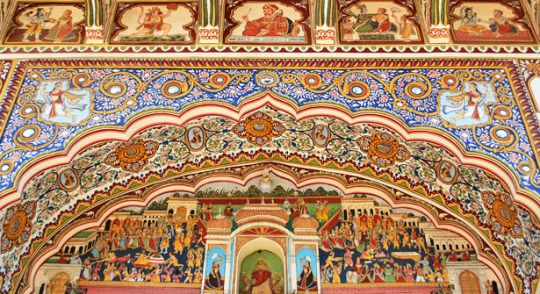
Mahansar - Around 6 km from Bissau is another small village, Mahansar which was founded by Nawal Singh in the 18th century. The village does not overflows with attractions, yet some of the havelis with their fine paintings are worth visiting. Prominent among these is the Sona ki Dukan Haveli which has exquisite meenakari work to delight the visitors. Sahaj Ram Poddar Chhatri is also worth visiting.
Mandawa - One of the most visited destinations in the Shekhawati region, Mandawa came into limelight in the 18th century. It has an imposing fort, Castle Mandawa that serves as a heritage hotel today. Other attractions of the town include the havelis of Chokhanias, Goenkas Nevatia & Ladia and Saraf. Parasrampura - The tiny village preserves some of the oldest and most beautiful paintings of the Shekhawati region. The paintings on the inner portion of the dome of Thakur Shardul Singh cenotaph, Shamji Saraf Haveli and Gopinathji Mandir is worth appreciating.
Sikar - Now a district headquarters, Sikar was once the largest thikana (feudatory) under the Jaipur State. Important attractions here are the havelis of Biyani, Murarka, Somani, Sagarmal Sodhani and Madho Niwas. The Sikar Fort, Jublee Hall, Jain Temples, Gopinath Temple, Raghunath Temple, Jeen Mata Temple and Madan Mohan Temple in and around Sikar are also worth visiting.
Mukundgarh - Mukundgarh is a small town developed around a temple square. The Mukundgarh Fort serves as a heritage hotel. Tourists can pay a visit to the Kanoria and Ganeriwala Havelis and also shop for local handicrafts. Mukundgarh is highly known for its brass, iron scissors and textiles. Churu - Though Churu does not come in the Shekhawati region strictly, yet its history of traders and caravan outpost connects it with other places in Shekhawati. Place worth visiting here are the Kanhaiya Lal Bagla Haveli, Kothari Haveli, Surana Haveli, Poddar Haveli, Jain Temple, Balaji Temple, Ganga Temple, Taknet Chhatri and not to forget the Churu Fort.
Khetri - The second richest feudatory of the Jaipur state, Khetri was established in the 18th century. Prominent places worth visiting are Raghunath Temple, Bhopagarh Fort , Panna Lal Sha ka Talab, Ram Krishna Mission, Sukh Mahal and Hari Singh Temple. Pilani - This small village gained prominence as the home of wealthy Birla family. Today, the place is more known for its educational significance. For tourists sightseeing, there is BITS museum, Shiva, Ganga, Sarswati Temple and the Panchwati Temple.
For visiting the shekhawati regions of rajasthan you must need a tour packages from a experienced tour operator. we have a many customize tour packages for entire rajasthan. visit our website for more information about the rajasthan and its tourist attractions.
Rajasthan Tour Packages Rajasthan Car Rental Packages Rajasthan Diwali Tour Holiday Tour Packages Rajasthan Tourism
1 note
·
View note
Text
Politicians, bureaucrats & civilians pay last respects to General Bipin Rawat
Union Home Minister Amit Shah, National Security Adviser Ajit Doval and senior Congress leader Rahul Gandhi were among those who visited the residence by around 11.30 am.
From senior politicians and official dignitaries to civilians, the residence of Chief of Defence Staff (CDS) General Bipin Rawat was flooded with people coming in to pay their last respects.

With the last rites to be conducted later in the afternoon, people were seen queuing up outside the house much before the mandated time of 11 am.
Rawat had died in a helicopter crash on Wednesday near Coonoor, along with his wife Madhulika and 11 other military personnel.
In the morning, leaders from the government, the Opposition, bureaucracy and security establishment visited Rawat’s residence on Kamraj Marg. His and his wife’s mortal remains will be kept at the residence till 2 pm. Following that, it will be taken to Brar Square Crematorium, where he will be cremated with full state honours.
Union Home Minister Amit Shah, National Security Adviser Ajit Doval and senior Congress leader Rahul Gandhi were among those who visited the residence by around 11.30 am. Uttarakhand Chief Minister Pushkar Singh Dhami, former CM Harish Rawat, Haryana Chief Minister Manohar Lal Khattar and Union Ministers Anurag Thakur and Gajendra Singh Shekhawat were also present.
DMK’s Kanimozhi K, Akali Dal’s Harsimrat Kaur Badal, BJP’s Ravi Shankar Prasad, Jay Panda, Congress senior leader Mallikarjun Kharge and his party colleague K Suresh also came in later to pay their tributes.
Among the top bureaucrats were Principal Secretary to PM PK Mishra and Cabinet Secretary Rajeev Gauba, who were seen together. From the security establishment, apart from several senior military personnel, heads of CRPF and ITBP went to the CDS’s house to pay their tributes.
Civil society leader and Nobel laureate Kailash Satyarthi was also seen paying his respect.
Delegates spent around 10 to 15 minutes each inside the premises. Amid a tight security cordon outside the house, with only select people being allowed to go in, there was a small crowd from his home state of Uttarakhand shouting slogans for him. “General Rawat Amar Rahe, Madhulika Rawat Amar Rahe,” the supporters, who were not allowed to go in, said.
There was also a section who started chanting slogans like “VIP culture must be ended” as they got impatient waiting outside.
0 notes
Link
This is about the extraordinary fellowship that created between Maharaja Ajit Singh Bahadur, the leader of the Shekhawat line of the august territory of Khetri in Rajputana and Narendra Dutta, a priest who passed by the name of Swami Bibidishanand.
0 notes
Text
KPL fixing: Plugging multiple gaps in state-run leagues - cricket
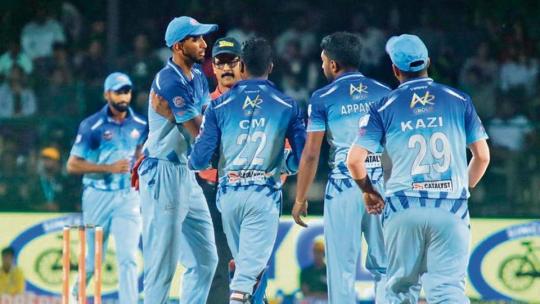
The match-fixing scandal of 2000 erupted when Delhi Police chanced upon telephone conversations between Sanjay Chawla, a bookmaker and businessman, and South Africa cricket captain Hansie Cronje while probing a low-profile extortion case.In September last year, investigations into the Karnataka Premier League (KPL) had a similar beginning.“We started with a small tip-off about betting,” says Sandeep Patil, Joint Commissioner of Police, Crime, Bengaluru City. Betting on cricket is illegal but rampant, and the police were chasing what they thought was a routine crime.Since then, the police have questioned more than 40 cricketers, coaches, administrators, franchise owners and bookies. They have arrested nine people (all out on bail), including two team owners and four players.“As we went further, we realised how big it is. It not only involves betting but also match-fixing, and a deadly combination of team owners betting on a very large scale,” says Patil, who heads the Special Investigation Team (SIT) probing the case.LEAGUE HALTEDCurrently on hold till investigations end, KPL began in 2009 and was the first of the IPL-style T20 state leagues that now take place across the country. A realtor company came in as a sponsor, committing ~11 crore over five years, and a local cable network company was roped in as broadcast partner.“(But) unlike IPL, there was no revenue model,” says a former administrator in the Karnataka State Cricket Association (KSCA) requesting anonymity.Also Read: Why Kohli and Co start as favourites in series decider against AustraliaIn November 2010, there was a change of guard at KSCA. Former India cricketer Brijesh Patel—now IPL chairman, he had launched KPL when at the helm of KSCA—was replaced by Anil Kumble. The former India captain accused Patel of conflict of interest in the matter of hiring the company that was conducting IPL. Patel denied the charge, but the Kumble-led KSCA decided to discontinue KPL from 2011. Kumble said KPL “gave a backdoor entry to people not passionate about cricket”. Another two years, another reversal. By the end of 2013, Patel was back, elected secretary of the association, and KPL resumed the following year. In the same year, a KPL franchise found out that a player was passing information to bookies. In the absence of formal anti-corruption measures, the league management, fearing they would be black-listed by sponsors, let him off.Soon, old problems resurfaced. Seeing insignificant returns on investment, realtors, politicians, telecom companies and sports management firms began to opt out of the league. Sports broadcast majors Sony, followed by Star Sports, came in as partners but brought little money. The production and up-linking costs had to be borne by KSCA and the promised revenue share from ad-spots was limited.“In Karnataka, it’s difficult to find investors in cricket. In the 1980s and early 90s, sponsorship used to come from the banking sector. Now, the state economy is largely driven by the IT sector. Their clientele is (the) US market. and to some degree, UK. They are not interested in investing in a local cricket league. So, you take whatever comes,” says the former KSCA administrator.That meant frequent changes in team owners and ownership patterns. Somewhere in that disruption, Ali Ashfaq Thara bought KPL team Belagavi Panthers, and Arvind Reddy, a real estate developer, acquired Bellari Tuskers.Thara, who also owned a T10 league team in the UAE, police discovered was heavily into betting. He was also the first to be arrested. Thara has been suspended from both leagues.“It’s (fixing) been going on for the past three years. It multiplied after the arrival of Ali. He took players to New Zealand and Dubai. We gather some players were honey-trapped. We are investigating further,” says a police official.“For 10-12 players, there were separate apartments booked. This, so that dealings could happen away from anti-corruption officials,” says another policeperson who too did not want to be named.“We still don’t know all those who are involved. They (KPL) have an anti-corruption unit. What were their reports? What action was taken on the reports such as these need to be looked into,” says Patil.KSCA president Roger Binny, the 1983 World Cup winner, refused to be interviewed for the story. Through a KSCA press release, Binny has said: “With the unfortunate turn of events during the past few weeks, with regard to the KPL, we have reaffirmed time and again that we are fully co-operating with the police authorities to ensure that if anyone has wronged the sport, they will be subject to due process of law.”Brijesh Patel too refused to comment.SHADY DEALSPlayers too had begun to realise something was amiss. In the 2017 season, a coach was found carrying a bag full of new iPhones to distribute among players. During a 2017 KPL tie, an India player had a public spat with two competing franchise owners because he felt the match was being rigged. Another captain, who did not wish to be named, says he would announce the team minutes before the toss because he didn’t trust his teammates to play fair.Also Read: Rohit Sharma four runs away from surpassing Sourav Ganguly in elite listThe same year, an India player and a Karnataka player who played in IPL reported suspicious activities to KSCA. The players say nothing was done. In 2019, a furious India player lashed out at teammates after he sensed more than one was not playing to win, a player requesting anonymity says. ESPNcricinfo reported of international betting firms suspending trading after observing unusual betting patterns in KPL.In 2018, when former ICC ACU head Ravi Sawani’s private security unit was tasked with anti-corruption duties in the league, multiple corrupt approaches came to light and were shared with KSCA.Last year, when BCCI’s ACU took over duties in all state leagues, they alerted the administration.“Before we took over this year, our zonal operations manager was asked to brief them because earlier too there were rumours of KPL being compromised,” says Ajit Singh, BCCI ACU head.CONFLICT RIFEAmong the arrested is KSCA managing committee member Sudhindra Shinde. His cricket club Socials was one of those which provided players to the league. Following Shinde’s arrest, police raided KSCA secretary Santosh Menon’s house.“What we (can) make out from our investigations so far is this (conflict) thing of administrators being selectors and also running cricket camps and coaching centres. We have seen when the officials are running these coaching camps, most of the players are coming from there. They push these players to various teams of KPL so that they start dancing to their tune. They make them do small things and later spot-fixing even in the final,” says Patil.Police say it’s easy to influence players; they can be honey-trapped— three actors from the Karnataka film industry too are under investigation—tempted with money, or blackmailed that failure to comply would mean exclusion.Runners-up in 2019, Bellari Tuskers owner Reddy, captain CM Gautam and Abrar Kazi have been charged with fixing. The police also nabbed M Viswanath, Nishant Shekhawat and coach Vinoo Prasad. They are currently out on bail (charged with cheating under Section 420 of the Indian Penal Code) and have been suspended by KSCA.The police has sent a notice with 18 questions to KSCA and KPL franchises seeking information around the franchise-ownership pattern and individual disclosures. Thara, according to the police, registered his team in his wife’s name.“They have only replied with half-baked information. We have asked them for more,” says Patil.“So far, we have reached only 25-30 per cent of our enquiry. We are going to take it to its logical conclusion. It requires lot of detailed investigation which is underway,” says Patil.“We have evidence to point to Belagavi team owner as well as Bellari team owner. There are question marks on teams like Bijapur (Bulls) and others which we are investigating.”With the reputation of Karnataka cricket, which has produced some of the greatest names in the game, at stake, there have been calls to stop KPL for good. Not everyone agrees such a drastic step should be taken.“The two leading white-ball teams in the country currently are Karnataka and Tamil Nadu. Have they not benefitted from KPL and TNPL? Have they not scouted talent for IPL? What’s needed is better governance mechanism in the league,” says a former cricketer who did not want to be named.HANDLING it: GangulyBCCI too is keeping a tab. It’s ACU is probing, but will rely heavily on the police. “Whatever evidence they quantify to file a chargesheet, we will require that to ascertain the violation of anti-corruption code,” Ajit Singh says.BCCI president Sourav Ganguly said the onus was on players to stay clean. “Players are approached, that is not the problem. What they do after is the problem. We’re dealing with it because nobody wants it.”Patil says: “If the owners and administrators are above board, such a thing cannot happen.”Other T20 state leagues aren’t immune to the problem. NPL recently expelled two co-owners of a franchise for links with bookies. A franchise owner of T20 Mumbai, the Mumbai Cricket Association (MCA) run league, is being investigated.The KPL investigations serve as a reminder that the lessons of 2013 IPL spot-fixing scandal have not been learnt well. Read the full article
#announcement#bnewsbijapur#bnewschannel#bnewschannelwiki#bnewsdeoria#bnewsfacebook#bnewshindi#bnewskolhapur#bnewskolhapurlive#bnewslogo#bnewstvchannel#bulletins#cnewsbharat#cnewsbharatlogo#cnewsbharatup/uk#cnewschannel#cnewslivetv#cnewslogo#cnewsmarathi#cnewstv#cnewsup#cnewsvideo#cosmosnews#Cricket#dnewsapp#dnewsappdownload#dnewschannel#dnewshindi#ddnews#ddnewsanchor
0 notes
Photo

BCCI ACU Chief Calls for Match-Fixing Law, Legalised Betting to Contain Corruption The BCCI's Anti-Corruption Unit chief Ajit Singh Shekhawat on Tuesday suggested a match-fixing law, besides legalisation of betting, to tackle corruption in Indian cricket. via Top CricketNext News- News18.com
0 notes
Photo

Smart Solar Grass Cutter Robot
by Ajit Singh Shekhawat | Nikesh Kumar | Roopal Yadav | Siddharth Tyagi | Arun Pratap Singh "Smart Solar Grass Cutter Robot"
Published in International Journal of Trend in Scientific Research and Development (ijtsrd), ISSN: 2456-6470, Volume-3 | Issue-3 , April 2019,
URL: https://www.ijtsrd.com/papers/ijtsrd23320.pdf
Paper URL: https://www.ijtsrd.com/engineering/mechanical-engineering/23320/smart-solar-grass-cutter-robot/ajit-singh-shekhawat
international journals in engineering, call for paper engineering, paper publication for engineering
Today, we know that solar energy is a renewable source of energy. And the fossils fuel may not be available in the future and it also pollutes to our environment. So we have to use, one of the most promising source of energy where everyone focusing on the concept of solar power and its utilization. Smartly grass cutting robot detects obstacles by the ultrasonic sensor with servo in wide range for avoiding obstacles without any need of human interaction. All the motors, sensors and cutting operation are automatically controlled by the Arduino and manually by Bluetooth module. And the cutting operation is performed by single metallic thread which is operated by DC motor 10000 rpm . Cutting robot batteries charged by a charging dock which is located in the ground separately. Charging dock is attached with the Solar panel and charging controller.
0 notes
Text
BCCI-ACU chief Ajit Singh Shekhawat calls for legalization of betting in India to curb corruption in cricket
BCCI-ACU chief Ajit Singh Shekhawat calls for legalization of betting in India to curb corruption in cricket
[ad_1]
He mentioned once betting is legalized, data can be used in order to keep an eye on illegal betting and how much money flows in the process.
A view of logo of the Board of Control for Cricket in India (BCCI). (Photo by Aniruddha Chowhdury/Mint via Getty Images)
Betting and match-fixing have become big demons for the game of cricket. Many of big-name cricketers have fallen prey to the…
View On WordPress
0 notes
Text
BCCI ACU chief calls for legalising betting
BCCI ACU chief Ajit Singh Shekhawat calls for legalising betting
Board of Control for Cricket in India (BCCI’s) Anti Corruption Unit head Ajit Singh Shekhawat suggested that legalising betting and bringing a strong law against cheating in sport would help in tackling issues of match-fixing in cricket.
Shekhawat, who was the Director General of Police in Rajasthan before taking charge of BCCI’s Anti-corruption Unit in April 2018, gave his suggestions in an…
View On WordPress
#bcci#ipl#is betting legal in India#is online gambling legal in india#justice lodha#law commission#legalising betting#mudgal
0 notes
Text
Most tourist Attractions in Shekhawati
Shekhawati region of Rajasthan consists of the areas falling under Sikar, Jhunjhunu and some parts of Churu, Nagaur and Jaipur. There are thousands of Villages and Towns which comes under Shekhawati region. Shekhawati is famous for its rich heritage and beautiful architectures full of fresco paintings , hence also known as “open air art gallery
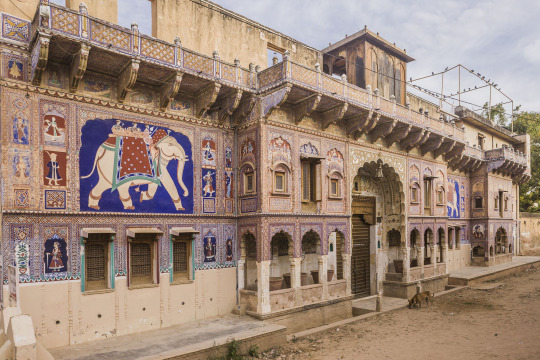
Nawalgarh - Named after its founder Thakur Nawal Singh (son of the most successful ruler of Shekhawati, Shardul Singh), Nawalgarh was a prosperous town in Shekhawati region. Some of the affluent business clan of India today trace their origin from Nawalgarh. Prominent among these is the Goenka family. The havelis of the town - Aath haveli, Murarka Haveli, Khedwal Bhawan, Bhagton ki Haveli and Anandi Lal Poddar Haveli - are its prime attraction. The frescoes and mural paintings are extremely attractive and reflect the skills of the workmen who created them. Other attraction of Nawalgarh is Ganga Mai Temple.
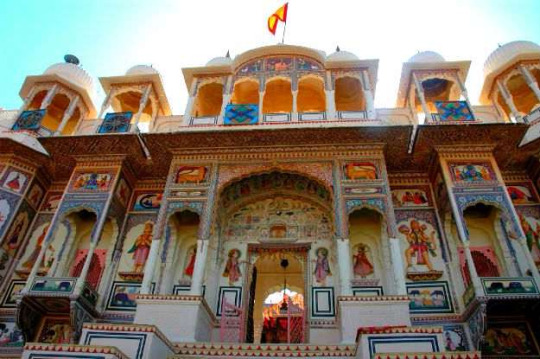
Dundlod - A small village in the Shekhawati region is known for a small fort built in the 18th century by Kesri Singh, youngest son of Sardul Singh. The fort has a Diwan Khana with portraits and period furnitures as well as a small library. The fort now serves as a hotel. Other attractions to be visited here are Tuganram Goenka Haveli, SatyaNarayan Temple and Jagathia Haveli. This village is 7 kms north of Nawalgarh.
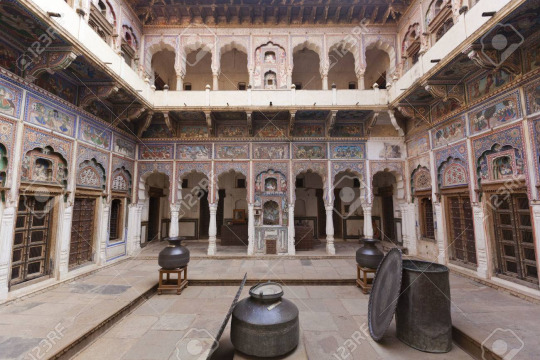
Fatehpur - Established by Fateh Khan, a Muslim Nawab in 15th century, Fatehpur was captured by the Shekhawat Rajputs in the 18th century. The place boasts of some of the best fresco paintings of the region, however, unfortunately, the havelis housing them are more often locked. The worth seeing havelis in this place are Geori Shankar Haveli, Mahavir Prasad Goenka Haveli, Nand Lal Devra Haveli and Jagannath Singhania Haveli. There is also the Jagannath Singhania Chattri with beautiful garden which is worth visiting.
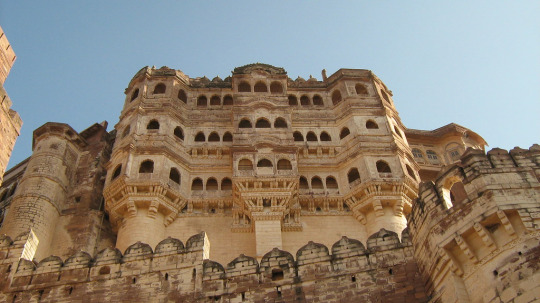
Ramgarh - Around 20 km from Fatehpur lies Ramgarh which was founded by a group of affluent Poddar merchant in the 18th century. The primary attraction of the town is Ram Gopal Poddar Chhatri that has beautiful scenes of Ramayana painted on its ceilings. Fresco paintings in Shani Mandir (Saturn Temple) are also eye catchers. Other attraction of the place include Ganga Temple, Ganes Temple, Tarachand Ghanshyamdas Poddar Haveli and Baij Nath Ruia Haveli.
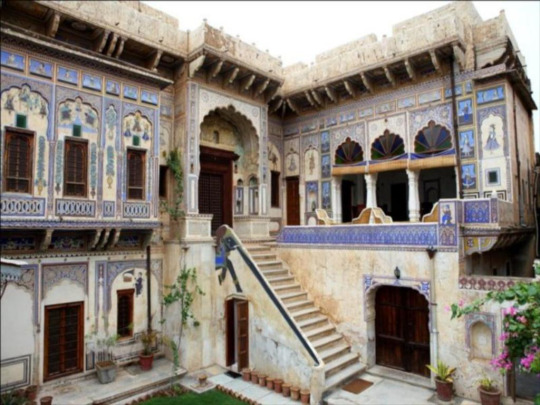
Jhunjhunu - Currently a district head quarter, Jhunjhunu was founded by Kaimkhani Nawabs in the 15th century. Places worth visiting in this town are Badani Chand Well, Mertani Baori, Ajit Sagar, Dargah of Kamrud-din Shah, Badal Fort, Khetri Mahal, Bihariji Temple, Rani Sati Temple and Forest Ganj. The significant havelis of this place are Modi Haveli, Kaniram Narsingh Das Tiberwala Haveli, MohanDas Ishwar Das Modi Haveli and Narudin Farooqi Haveli.
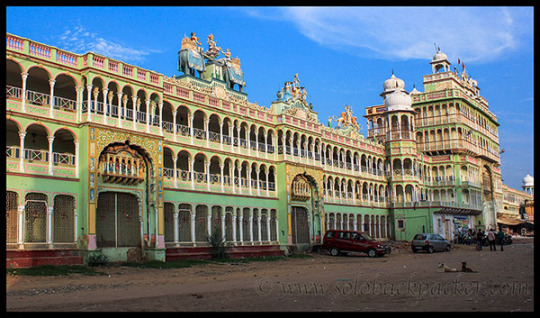
Bissau - Nearly 32 km north west of Jhunjhunu is a small town known as Bissau. The town was founded by Kesri Singh and has seen numerous ups and down. Important attractions here include Chhatri of Hammir Singh, Haveli of Girdarilal Sigtia and Motiram Jasraj Sigtia Haveli. The last one today serves as a junior school.
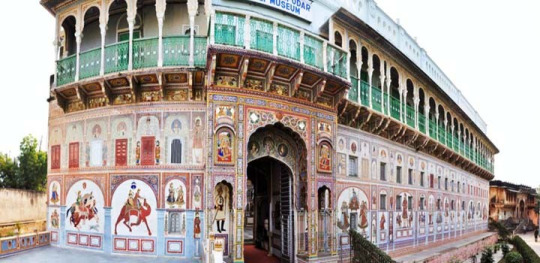
Mahansar - Around 6 km from Bissau is another small village, Mahansar which was founded by Nawal Singh in the 18th century. The village does not overflows with attractions, yet some of the havelis with their fine paintings are worth visiting. Prominent among these is the Sona ki Dukan Haveli which has exquisite meenakari work to delight the visitors. Sahaj Ram Poddar Chhatri is also worth visiting.
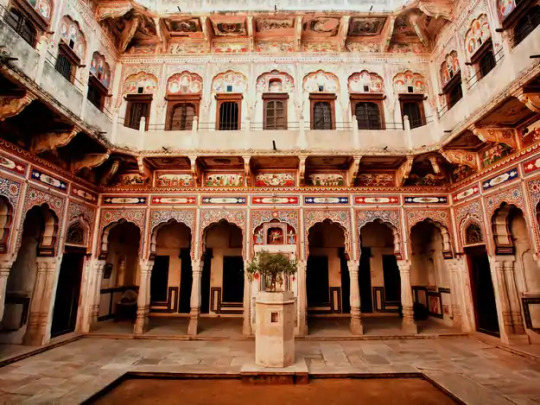
Mandawa - One of the most visited destinations in the Shekhawati region, Mandawa came into limelight in the 18th century. It has an imposing fort, Castle Mandawa that serves as a heritage hotel today. Other attractions of the town include the havelis of Chokhanias, Goenkas Nevatia & Ladia and Saraf. Parasrampura - The tiny village preserves some of the oldest and most beautiful paintings of the Shekhawati region. The paintings on the inner portion of the dome of Thakur Shardul Singh cenotaph, Shamji Saraf Haveli and Gopinathji Mandir is worth appreciating.
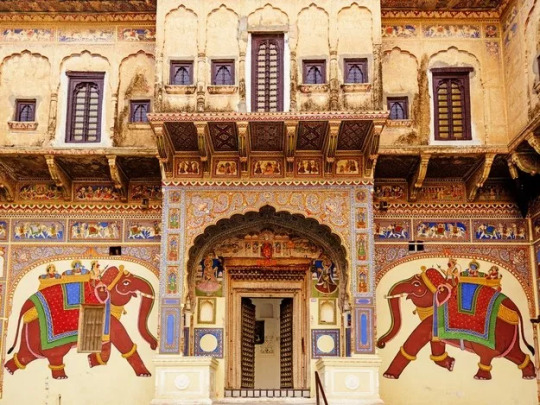
Sikar - Now a district headquarters, Sikar was once the largest thikana (feudatory) under the Jaipur State. Important attractions here are the havelis of Biyani, Murarka, Somani, Sagarmal Sodhani and Madho Niwas. The Sikar Fort, Jublee Hall, Jain Temples, Gopinath Temple, Raghunath Temple, Jeen Mata Temple and Madan Mohan Temple in and around Sikar are also worth visiting.
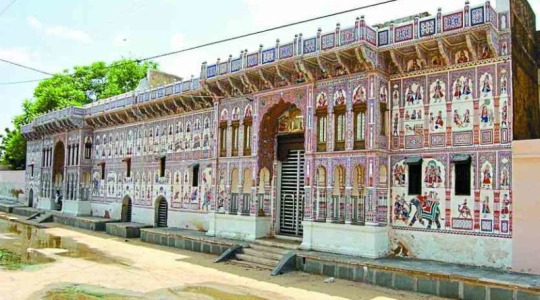
Mukundgarh - Mukundgarh is a small town developed around a temple square. The Mukundgarh Fort serves as a heritage hotel. Tourists can pay a visit to the Kanoria and Ganeriwala Havelis and also shop for local handicrafts. Mukundgarh is highly known for its brass, iron scissors and textiles. Churu - Though Churu does not come in the Shekhawati region strictly, yet its history of traders and caravan outpost connects it with other places in Shekhawati. Place worth visiting here are the Kanhaiya Lal Bagla Haveli, Kothari Haveli, Surana Haveli, Poddar Haveli, Jain Temple, Balaji Temple, Ganga Temple, Taknet Chhatri and not to forget the Churu Fort.

Khetri - The second richest feudatory of the Jaipur state, Khetri was established in the 18th century. Prominent places worth visiting are Raghunath Temple, Bhopagarh Fort, Panna Lal Sha ka Talab, Ram Krishna Mission, Sukh Mahal and Hari Singh Temple. Pilani - This small village gained prominence as the home of wealthy Birla family. Today, the place is more known for its educational significance. For tourists sightseeing, there is BITS museum, Shiva, Ganga, Sarswati Temple and the Panchwati Temple.
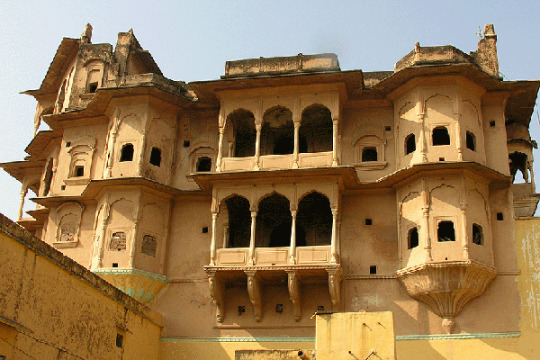
We are the best tour packages & car rental service provider in rajasthan India.
For More information- https://www.rajasthantourplanner.com/
0 notes
Text
Probe over women's cricket match-fixing claim
New Post has been published on https://thebiafrastar.com/probe-over-womens-cricket-match-fixing-claim/
Probe over women's cricket match-fixing claim
Image copyright Getty Images
Image caption India’s sports betting industry is among the worlds largest
Indian police have registered a case against two alleged bookies for approaching a cricketer from the women’s national team to fix matches.
The alleged incident took place in February before the start of a limited-overs series against England.
Rakesh Bafna and Jitendra Kothari are accused of cheating and gambling, police told BBC Hindi’s Imran Qureshi.
India’s sports betting industry is among the world’s largest, with estimates ranging from $45bn to $150bn.
The two men approached the female cricketer pretending to be sports managers. She is believed to have recorded the phone call she had with Mr Bafna, which she later reported to the Board of Control for Cricket in India (BCCI).
It’s unclear when she reported the incident to the board but the board alerted the police on Monday.
Media playback is unsupported on your device
Media captionSameer Hashmi takes a look at how match-fixing scandals have rocked Indian cricket
“People involved in betting just need any cricket match. For them, it does not matter at what level it is being played,” Ajit Singh Shekhawat, a BCCI official, told local media.
He said that the incident shows that women cricketers are just as exposed to bookmakers as their male counterparts, and should be equally cautious.
News reports suggest that more than $190m worth of bets are placed on a single one-day international match involving the Indian national cricket team.
Indian cricket has been hit by match-fixing scandals in the past, which included the involvement of the former captain of the men’s national team, Mohammad Azharuddin.
The lucrative Indian Premier League (IPL) too has been marred by similar allegations – and committees headed by Indian judges have found that several figures involved in the IPL were guilty of match-fixing and illegal betting.
Read More
0 notes
Text
Salman Khan Will get Trolled By Netizens For Biking With out Security!
http://tinyurl.com/y4k4vh49 Salman Khan is driving excessive on the success of Bharat and why not, the film has finished a enterprise of greater than 200 crores. And possibly that’s the rationale Salman has levelled up his social media recreation today. He has been posting every so often and giving us a glimpse inside his stardom. Yesterday he posted a video driving a bicycle from his home, Galaxy residences to Mehboob Studios in Bandra which is a journey of simply 5 minutes. He posted a quick ahead video and captioned it, “Time flies and life passes by v rapidly so discover ways to admire it ..” This isn’t the primary time when Salman was noticed biking, we now have seen him fairly just a few instances biking in his neighborhood. Whereas numerous followers had been impressed to see this avatar of the star however just a few had been dissatisfied due to him not sporting a helmet and slicing visitors randomly. In truth, just a few followers tagged Mumbai Site visitors Police and requested them to take motion towards him. Biking in the course of the street. Placing each one at risk. — Rashmi (@fivemilestone) June 27, 2019 Large fan however not setting a very good instance of Security right here. The place is the safety gear and why promote driving slicing dangerously into visitors. — Ajit Singh Shekhawat (@shekhawat_23) June 27, 2019 Helmet @MumbaiPolice @mtptraffic — Chandresh Jain (@COOL_Chandresh) June 27, 2019 On the work entrance, Salman is presently taking pictures for Dabangg three reverse Sonakshi Sinha and film can be launched by the tip of this 12 months. Android & IOS customers, obtain our cell app for sooner than ever Bollywood & Field Workplace updates! (function(d, s, id) { var js, fjs = d.getElementsByTagName(s)[0]; if (d.getElementById(id)) return; js = d.createElement(s); js.id = id; js.src = "http://connect.facebook.net/en_US/sdk.js#xfbml=1&version=v2.8&appId=379203805755441"; fjs.parentNode.insertBefore(js, fjs); }(document, 'script', 'facebook-jssdk')); Source link
0 notes
Link
via Today Bharat "If Leander Paes can win Grand Slams at 42, I can at least play some cricket at 36," India cricketer S Sreesanth said after the Supreme Court set aside the life ban imposed on him by the BCCI for his alleged involvement in the 2013 IPL spot-fixing scandal. Sreesanth, along with Mumbai spinner Ankit Chavan and Haryana's Ajit Chandila, were suspended for life by a BCCI disciplinary committee in 2013, a decision that the player had challenged in court. Speaking to PTI after a favourable verdict by the apex court on Friday, a relieved Sreesanth said: "I don't know what life has in store for me after all these years. It's six years and I haven't played cricket, which was my life." "I hope that the BCCI respects the verdict of the country's highest court and allows me to at least get back to the cricket field. I hope that at least now I can walk to a school cricket ground and train there without being told that I am not allowed. I just want to play whatever cricket I can," said Sreesanth, who has been a part of the 2007 World T20 and 2011 ODI World Cup winning squads. But age is not something that he feels will be a factor in trying to make a comeback to competitive cricket. "Your age is as much as you feel. I would again like to play club cricket in Scotland. I wanted to play last year but didn't get permission. I can't play club cricket in England at the moment as I have not played first-class cricket for six years now," said Sreesanth, who has represented the country in 27 Tests, 53 ODIs and 10 T20 Internationals, respectively. Sreesanth said in his "dark days", it was the unshakeable faith of his parents, wife Bhuvaneshwari, in-laws and his loyal fans that kept him going. "I want to thank my in-laws, the Shekhawats. They trusted me and let their daughter marry me when the whole world didn't trust me. My parents have gone through a lot during all these years. Trust me it wasn't that easy all these years," said Sreesanth, who is still in touch with some of his Indian teammates. "Yes, I do get calls or whatsapp messages from some of them. Bhajju paa (Harbhajan Singh) has spoken to me, Viru bhai (VIrender Sehwag), Suresh (Raina) have kept in touch. I keep speaking to Robin (Uthappa) who is a dear friend," he said. His children -- a son and a daughter -- are yet to attain the age in which they can understand what their father has gone through. "All these years, I would often sit and think that what should I be telling my kids and what would be their idea about me as a father. Now when they grow up, I can at least tell them that their father's biggest strength was not ever giving up on a fight even in toughest of times," said Sreesanth. "They will know that their father was sent to jail, endured tough times, fought all the false allegations and came out stronger. They can imbibe strength from my story," said the pacer, as he got ready to leave for his hometown after attending the court proceedings. Once considered the enfant terrible of Indian cricket with serious attitude issues, for the past few years, the song that would infuse life in him is 'Rise Up' composed by Swedish DJ Yves 'Larock' Cheminade. For Sreesanth, the moto of life is "Rise up! Don't fall down again Rise up Long time I broke the chains I try to fly a while so high Direction - sky".
0 notes
Text
The great kings settled in Jodhpur and saved
Rajasthan History –
Rajasthan History provide printed Hindi E-books and articles on history and culture of Rajasthan and Indian History.
The great kings settled in Jodhpur and saved
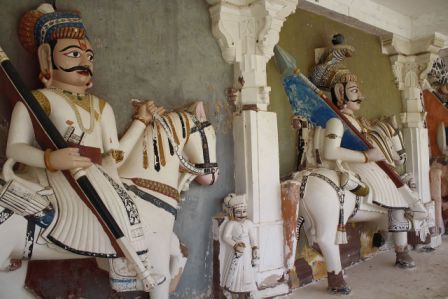
Rao Jodha, who settled Jodhpur, was a big warrior king. At the age of 12 he lived with his father in the battlefield and fought with the enemies. In 1438, when his father Razal was killed in Mewar, Jodha proceeded from Chittor to Jodhpur with his seven hundred Rathore warriors. Mewar's army followed Rathod, but Jodha succeeded in reaching Marwar with only eight Rathods, who courageously fought Mewar's army. Mewar's army took control over the Mandor. By continuing to fight for 15 years, Jodha not only took away Marwad, who had gone to the mouth of Maharana Kumbha, but also married the princess of Mewar. By establishing Jodhpur fort in AD 1445, Jodha made Marwar state safe forever. Until that time, cities like Jaipur, Bikaner and Udaipur were in the womb of future. Jodhha's descendants ruled Jodhpur for 490 years. His queen Jasamade Hadi made the Ranisar pond Jodha's son Satlal's queen Bhutani created the Phulhalava pond in AD1490. Jodhha's descendants, Ganga built a temple of Gangavla in Jodhpur, Baadhi of Ganga and a temple of Gangesamji. Padmavati of Ganga was the daughter of Maharana, who had built a Padamshar pond in Jodhpur. Maldeo, the son of Ganga, expanded the fort of Jodhpur and built a quote around the queen. He took the waterfalls of Chidiyannath into the fort and surrounded the coat and made a city sanctuary around Jodhpur. His queen Swarupdevi built a pond of Bahuji. The descendants of Jodha, Surasingh built the palaces of Foothills in Surasagar Talab, Rameshwar Mahadev Temple, Surajkund Bawdi and Jodhpur in the city outside Chandpol. His successor, Gaj Singh, built a new palace in the Jodhpur fort, Tomb of Tomb, next of the hall, Diwakhana, beach pole, Kothar, kitchen, Anandghanhi temple, several palaces in the palaces of the foothills, Kua, garden and palace in Sauragar. His son Jaswant Singh planted pomegranate garden in Jodhpur by procuring mud of clay and pomegranate seeds and plants in Jodhpur in Jodhpur. Jaswant Singh's Hadi was the daughter of Rani Bundi Naresh Shatrushal, who built a garden called Raika Bagh outside Jodhpur Nagar. This queen also built a pond called Kalyansagar which was later known as Ratana. Shekhawat of the Jaswant Singh Rani Khandela had made, Shekhawataji's pond in Jodhpur. Jaswant Singh's son Ajit Singh built a coat between Fatapol and Gopal Pol in Jodhpur fort. He built a temple of Ghanshyamji in Jodhpur fort and the temple of the original Nayakaji in Daulat Khan, Fatahmahal, Dusal, Khawwahah's palace, Rangasal and small Janana Mahal and Jodhpur city. His son Abhay Singh constructed the Abhayasagar Talab outside the Chandpole Gate and built a palace of Kukua, Flower Palace and Kachhwaji in Jodhpur fort. King Bakshasinh made the place of Kotwali between Jodhpur Nagar and Chowk for the sale of Nazis in Mandi. The town's hideout built in the time of Rao Maldev was now getting smaller, so Bakhatsinga expanded it again and made many improvements in the fort. During the time of Jaswant Singh, he built a square of the house of Dalanthana, crushing the warehouses near Lohapol, widening the road, and constructed a new pole of Janani Deodhi, new Surajpole and Anandghanhi in the fort. Vijaysinh son of Bakshasinh was one of the great kings of Jodhpur. He brought Gokulia Gusaiyan in Jodhpur and started spreading the culture of Braj in Jodhpur. He prohibited killing his organism in his state and got rid of his traditional work with the cashews and put them on other things. At that time, the temple of Gangesyamji in Jodhpur, temple of Balakrishnaji, Temple of Kunj Bihari, Gulab Sagar Talab, Giridichot, Maayal Bagh and his flute, Fateasagar and the temple of Murli Manoharji were built in the fort. Mansingh's grandson of Vijaysinh was a wonderful nagina of the epic of the great kings in the history of Jodhpur. He was a wise, virtuous and wise king. He established a library of several thousand books in Jodhpur under the name of book Prakash. He made his first translation of the first thirty-two chapters of the Tenth Wand of Shrimad Bhagavata, which was published in the name of Krishna Vilas. He made big pictures based on many religious texts, such as Ramayana, Durga Charitra, Shiva Purana, Shiva Mystery, Nath Charitra. Inside the fort in Jodhpur at Jodhpur, the wall opposite the Jaipol, Janani Dahdi, the tomb of Aes Devnath, the coat in front of Lohapol, the coat between the Jaipol and Dakhana pole, the road from Chakalaw to Rannis, the wall to protect it , Bhainu Poll, Chatrapeseva's Deodhi on Nathji Temple and Bhatiyani's Palace were built. It is said about Jodha, Vijay Singh and Mansingh - Jodh Beso Jodhpur Bridge Keele Brigpal Lucknow Kashi Delhi Man Kyo Nepal That is, Jodhpur settled in Jodhpur and Vijaysingh made it a Braj land by constructing the Vaishnava sect temple. Maharaja Mansingh called singers, wise men and yogis and made it Lucknow, Kashi, Delhi and Nepal. During the time of Maharaja Takhshingh, the walls of the Raniasar, Padamsar, Gulabsagar, Baiji ponds and fateasagar and their canals were expanded in Jodhpur. Baiji's pond pond was constructed. Rajmahal of Gulabsagar, the terrace of the Mandi valley, the shops on the east side of the temple of Gangesamji, the houses of the sari and the houses of Kotwali were made. Vidyasal outside Jodhpur town, palace of Balasamand, palace of palanquin, palace of kalana, Takhatsagar etc. were constructed. His Ranji Jadeji had built a palace and garden on the lake of Devraji near Balsamand. Magrajash, the greatness of Takhshing, was outside the Nagauri Gate and Lachhraj built bavalias in his name outside Jalori Darshan and Mata Chavadji of Takhtsingh built a temple of Fatebihari in front of the Tables. The Chamunda Mata Temple was rebuilt, which was blown up in the explosion of ammunition. At the time of Maharaja Jaswant Singh, Jodhpur was constructed as a new face. In his time, on July 3, 1876, opened a state school in Jodhpur for English language education. During his time Jodhpur was the first train to arrive. For the first time the post office opened. Arrangements have been made to bring drinking water in Jodhpur through the canals of Balasamand dam through the canals. The state printing press was established. Road to go from the Nagauri gates to the fort was made. Jaswant College was established for higher education. 15 Hospital open for medical treatment. Mailing and roads were arranged. Forest Department was established. Municipality opened Jaswant Sagar dam. From Maharaja Jaswant Singh to Maharaja Ummed Singh, Jodhpur received the services of Sir Pratap as Prime Minister. Modern Jodhpur's outline has been set for many. He was the younger brother of Maharaja Jaswant Singh. In the time of Maharaja Sardar Singh, the first Hindi hospital in Jodhpur was opened in the palaces of the foothills. In its time, to make the traffic smooth in the city, a new road was cut from the hill near Phulwala pond, and light was arranged on the streets of the city. Sardar Market and Ghatghar and Jaswant Thaar near the fort in the old Nazi Mandi named Giridi Coat. In his time Jodhpur Princely State started 1 Graduate College, 1 High School, 16 Vernacular Schools, 44 Anglo Vernacular Schools, 1 Rajput Nobel School, 1 Sanskrit School, 1 Normal School, 25 State Assisted Schools, 89 Post Offices and 23 Hospitals. Were. The length of the railway line was 525 miles and the work of Sardar Samand, Hemavas and Edward Samund started. Rajput High School was inaugurated at Chupassani during the time of Maharaja Sumer Singh, Sardar Museum was established in Jodhpur and Sumer Public Library was opened. Maharaja Ummed Singh can be called the creator of modern Jodhpur. During his time, Durbar became a new high school building and a new part of Jaswant College. The branch of Imperial Bank was opened in Jodhpur. The foundation of Umaid Palace was laid in the year 1929. Jodhpur became the largest hospital in the princely state, now called Mahatma Gandhi Hospital. - Dr. Mohanlal Gupta
For more information about Rajasthan History, visit our site - Click here
#indian history and culture#rajasthan history in hindi#ancient indian history#history of rajasthan#history of india#history of modern india
0 notes
Text
BCCI likely to appoint former Rajasthan DGP Ajit Singh as ACU head | Cricket News
BCCI likely to appoint former Rajasthan DGP Ajit Singh as ACU head | Cricket News
NEW DELHI: The BCCI is all set to appoint former Director General of Police (Rajasthan), Ajit Singh Shekhawat, as the head of its Anti Corruption Unit (ACU), replacing Neeraj Kumar.
It is learnt that the retired IPS officer would be taking charge of BCCI’s ACU unit before the start of the Indian Premier League on April 7. He retired as Rajasthan’s top cop on November 30.
A senior BCCI…
View On WordPress
0 notes
Text
Top Most tourist Destinations in Shekhawati
Shekhawati region of Rajasthan consists of the areas falling under Sikar, Jhunjhunu and some parts of Churu, Nagaur and Jaipur. There are thousands of Villages and Towns which comes under Shekhawati region. Shekhawati is famous for its rich heritage and beautiful architectures full of fresco paintings , hence also known as “open air art gallery”.
Nawalgarh - Named after its founder Thakur Nawal Singh (son of the most successful ruler of Shekhawati, Shardul Singh), Nawalgarh was a prosperous town in Shekhawati region. Some of the affluent business clan of India today trace their origin from Nawalgarh. Prominent among these is the Goenka family. The havelis of the town - Aath haveli, Murarka Haveli, Khedwal Bhawan, Bhagton ki Haveli and Anandi Lal Poddar Haveli - are its prime attraction. The frescoes and mural paintings are extremely attractive and reflect the skills of the workmen who created them. Other attraction of Nawalgarh is Ganga Mai Temple.

Dundlod - A small village in the Shekhawati region is known for a small fort built in the 18th century by Kesri Singh, youngest son of Sardul Singh. The fort has a Diwan Khana with portraits and period furnitures as well as a small library. The fort now serves as a hotel. Other attractions to be visited here are Tuganram Goenka Haveli, SatyaNarayan Temple and Jagathia Haveli. This village is 7 kms north of Nawalgarh.

Fatehpur - Established by Fateh Khan, a Muslim Nawab in 15th century, Fatehpur was captured by the Shekhawat Rajputs in the 18th century. The place boasts of some of the best fresco paintings of the region, however, unfortunately, the havelis housing them are more often locked. The worth seeing havelis in this place are Geori Shankar Haveli, Mahavir Prasad Goenka Haveli, Nand Lal Devra Haveli and Jagannath Singhania Haveli. There is also the Jagannath Singhania Chattri with beautiful garden which is worth visiting.
Ramgarh - Around 20 km from Fatehpur lies Ramgarh which was founded by a group of affluent Poddar merchant in the 18th century. The primary attraction of the town is Ram Gopal Poddar Chhatri that has beautiful scenes of Ramayana painted on its ceilings. Fresco paintings in Shani Mandir (Saturn Temple) are also eye catchers. Other attraction of the place include Ganga Temple, Ganes Temple, Tarachand Ghanshyamdas Poddar Haveli and Baij Nath Ruia Haveli.

Jhunjhunu - Currently a district head quarter, Jhunjhunu was founded by Kaimkhani Nawabs in the 15th century. Places worth visiting in this town are Badani Chand Well, Mertani Baori, Ajit Sagar, Dargah of Kamrud-din Shah, Badal Fort, Khetri Mahal, Bihariji Temple, Rani Sati Temple and Forest Ganj. The significant havelis of this place are Modi Haveli, Kaniram Narsingh Das Tiberwala Haveli, MohanDas Ishwar Das Modi Haveli and Narudin Farooqi Haveli.
Bissau - Nearly 32 km north west of Jhunjhunu is a small town known as Bissau. The town was founded by Kesri Singh and has seen numerous ups and down. Important attractions here include Chhatri of Hammir Singh, Haveli of Girdarilal Sigtia and Motiram Jasraj Sigtia Haveli. The last one today serves as a junior school.
Mahansar - Around 6 km from Bissau is another small village, Mahansar which was founded by Nawal Singh in the 18th century. The village does not overflows with attractions, yet some of the havelis with their fine paintings are worth visiting. Prominent among these is the Sona ki Dukan Haveli which has exquisite meenakari work to delight the visitors. Sahaj Ram Poddar Chhatri is also worth visiting.

Mandawa - One of the most visited destinations in the Shekhawati region, Mandawa came into limelight in the 18th century. It has an imposing fort, Castle Mandawa that serves as a heritage hotel today. Other attractions of the town include the havelis of Chokhanias, Goenkas Nevatia & Ladia and Saraf. Parasrampura - The tiny village preserves some of the oldest and most beautiful paintings of the Shekhawati region. The paintings on the inner portion of the dome of Thakur Shardul Singh cenotaph, Shamji Saraf Haveli and Gopinathji Mandir is worth appreciating.
Sikar - Now a district headquarters, Sikar was once the largest thikana (feudatory) under the Jaipur State. Important attractions here are the havelis of Biyani, Murarka, Somani, Sagarmal Sodhani and Madho Niwas. The Sikar Fort, Jublee Hall, Jain Temples, Gopinath Temple, Raghunath Temple, Jeen Mata Temple and Madan Mohan Temple in and around Sikar are also worth visiting.
Mukundgarh - Mukundgarh is a small town developed around a temple square. The Mukundgarh Fort serves as a heritage hotel. Tourists can pay a visit to the Kanoria and Ganeriwala Havelis and also shop for local handicrafts. Mukundgarh is highly known for its brass, iron scissors and textiles. Churu - Though Churu does not come in the Shekhawati region strictly, yet its history of traders and caravan outpost connects it with other places in Shekhawati. Place worth visiting here are the Kanhaiya Lal Bagla Haveli, Kothari Haveli, Surana Haveli, Poddar Haveli, Jain Temple, Balaji Temple, Ganga Temple, Taknet Chhatri and not to forget the Churu Fort.
Khetri - The second richest feudatory of the Jaipur state, Khetri was established in the 18th century. Prominent places worth visiting are Raghunath Temple, Bhopagarh Fort, Panna Lal Sha ka Talab, Ram Krishna Mission, Sukh Mahal and Hari Singh Temple. Pilani - This small village gained prominence as the home of wealthy Birla family. Today, the place is more known for its educational significance. For tourists sightseeing, there is BITS museum, Shiva, Ganga, Sarswati Temple and the Panchwati Temple.
0 notes